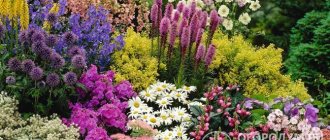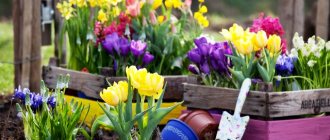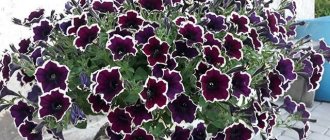Perennials come in an endless variety of shapes, sizes, colors and textures. The bright and attractive colors of perennials will create colorful compositions in your flower beds, rock gardens, flower beds and borders, in your containers, pots and baskets. Yellow is special in the color spectrum - it denotes joy and happiness. In addition to this, yellow is also the most visible color out of all the colors to the human eye. With a softer and more attractive hue than orange or red, yellow perennial garden flowers always have a charming effect. From subtle to vibrant, yellow perennial flowers always deserve a place in any garden.
Which yellow perennials to choose for the garden
You can enjoy yellow flowers in the garden throughout the growing season, from the fragrant flowers of Mimosa and Narcissus in spring to late-blooming perennials such as Rudbeckia. Yellow is a cheerful, sunny color and is very versatile - it can be paired with colors in red or orange, or contrasted with blue or purple for a softer look.
Yellow perennials will bring a bit of sunshine to your garden
If you are having a hard time choosing or identifying the right yellow perennials for your garden, you can check out this list of the best yellow perennial flowers. These perennials are grouped according to their growth. For quicker access, you can simply click on the names below to learn more about how to care for them.
How to choose flowers for your garden with a strong aroma: approaches
When choosing fragrant flowers, it is important that the smells combine with each other. Experts recommend that when choosing plants, you should be guided by the following points.
Unity of smell
Choose the dominant aroma in the area and select plants based on it. Most often, plants of the same species group correspond to this direction. For example, roses, mock orange or lilac. They choose a garden bush with fragrant flowers that sets the concept, and the rest of the smells are in unison.
Which low-growing yellow perennial flowers to add to your garden
Nature offers us a wide variety of ground cover yellow perennial flowers. And there is plenty to choose from:
Adonis
Members of the genus Adonis are generally short-growing plants, although some species can reach 50 cm in height. Perennial Adonis in a wide variety of shades have yellow flowers reminiscent of buttercups.
Photos of ground cover Adonis
Due to the very early flowering of these perennials, they are excellent for use in the garden and can look great when grown in garden path borders or rock gardens.
You might be interested
Choosing purple perennial flowers for your garden
Red perennials: the best plants to grow in the garden
List of the best blue flowers and plants with blue foliage
Perennial Cannes
Flower culture includes more than 50 species. Flowers in the form of paniculate or racemose inflorescences of a bright yellow, yellowish-orange hue.
Cannas in the garden go well with other low-growing flowers.
Daffodils
Another low-growing representative of bulbous plants, one of the first flowering garden crops. The ease with which most types of Narcissus can be grown is surprising because, being primarily native to Southern Europe and Northern Africa, they are highly adaptable to a wide range of soil and climate conditions.
Early spring is the time of Narcissus
Enjoy every moment of the Narcissus blooming in the spring, as it will be a whole year before you can enjoy their beauty and scent again.
Marigold
Another beautiful and useful perennial that blooms with yellow flowers. They are used in a variety of flower beds: in flower beds, ridges, on borders along paths, in rock gardens.
In flower shops you can buy marigold seeds of the most amazing shapes and colors.
They protect neighboring plants from pests such as aphids, cabbageweed and other insects. In the garden center you can always find marigold seeds of various colors and shapes.
Tulips
Representatives of bulbous perennials are well known to everyone. Incredible shapes and variety of colors of this flower.
There are few flower crops that can compare with the diversity of the tulip's color palette.
Yellow tulips of the Golden Apeldoorn, Yellow Crow, and Monte Carlo varieties begin to bloom in early spring, and can be grown in greenhouses all year round. Plants have strong elastic stems. They will not only complement your flowerbed, but will also become a wonderful decoration as a bouquet.
Tall yellow perennial flowers
To hide an unsightly fence or create a unique backdrop in your garden, simply plant tall perennials bearing yellow flowers in a row to create the illusion of a living fence. List of common tall garden flowers:
Imperial hazel grouse
A beautiful plant with a height of 60 cm to 1.2 m. The flowers are formed in the form of inflorescences consisting of “bells” of various shades: yellow, red, white.
Photo of yellow grouse (commons.wikimedia.org)
Blooming perennial yellow fritillary flowers will always attract attention. They are often planted in group plantings in a flower bed or in the space between bushes.
Dahlias
Thanks to their ability to maintain flowering until the first frost and easy care, these flowers are frequent guests of garden beds.
There are dwarf varieties for planting in containers and flowerpots, but most plants are quite tall and can grow up to 2.5 m. Dahlias require an area with good drainage and partial or full light.
Gladioli
If you are planning to decorate your garden with tall yellow flowers, then it is time to plant this unforgettable flower.
The second name of gladiolus is “sword” from the similarity of long narrow leaves with swords
Gladioli are the most frequent guests in most garden areas. You can choose from different shades to create a colorful flower garden.
Heliopsis rough
Perennial with yellow flowers, native to America. The most popular species is Heliopsis helianthoides.
Heliopsis is an excellent tall perennial for the background of a flower bed or mixborder. It has a bushy, well-branched form and shiny dark green triangular leaves. Flowering continues throughout the summer.
You can also add Kniphofia, Gelenium, Goldenrod, Eremurus and others to the list of popular tall yellow perennials.
Long-blooming yellow perennials
Perennial garden plants, as a rule, are not long-flowering, unlike annual crops. Perennials bloom for only one season, investing most of their energy in the roots, stems and foliage. But there are flowering perennial crops that can decorate the garden with their blooms for a couple of seasons. Here are some examples of such plants that will bring yellow sunshine to your garden.
Echinacea is strange
An herbaceous perennial, the most unique of the coneflowers, blooming with yellow flowers rather than purple. Hence the name E. paradoxa.
Easily adaptable look. Flowering period - from late spring to mid-summer. If you remove faded flowers in a timely manner, flowering can be extended. Definitely deserves a place in flower beds and other flower beds in the garden.
Rudbeckia
The flower has become one of our most popular garden plants in recent years, and it's no surprise - the densely growing plants produce masses of flowers with a long flowering period from July to October.
Rudbeckias are characterized by their bright, daisy-like flowers. Flower borders and flower beds, patios, containers, summer cottages - it will be an excellent addition to any flower arrangement.
Gaillardia aristata
A long-flowering perennial native to North America. Grows well in both wet conditions and dry areas.
Flowering time: summer-autumn. The flower is resistant to pests. Looks great in mixborders, as a border or container plant. It lasts a long time in a bouquet.
Garden Daylily
The perennial blooms yellow all summer and grows up to 45 cm in height. Provides color and contrast to a perennial flower bed.
This species can be effective in controlling soil erosion when planted on slopes. Elegant foliage provides background and texture to the garden when flowers are not in bloom.
Heliopsis sunflower
Flowering period: from June to September. An unusual flower with branched stems. This plant looks like real little sunflowers.
But unlike them, its petals are retained on the flowers. Heliopsis is hardy and easy to grow as a showy garden perennial in dry areas and is a good choice for clay soils.
Spring primroses
Yellow flowers, appearing almost from under the snow in early spring, are especially valued by gardeners for their beauty, brightness and early flowering. These delicate primroses can already transform a gloomy garden in April-May, decorating it with bushes with small or large buds of different shades of ocher. Below are the most popular perennials with photos and names, among the first to awaken from winter sleep, opening their petals under the rays of the warm sun.
- Crocus. This is a fairly unpretentious low-growing flower of the iris family, producing its small flower stalks up to 10 cm high almost immediately after the snow melts and the soil in the flowerbed warms up. Its spring flowering period is April-May; there are also varieties that bloom again in the fall, in August-September. Crocuses, in addition to their yellow color, are white, pink and dark blue, with a bluish tint and contrasting colored veins. They reproduce by small bulbs and grow well in acidic fertile soil for about 4 years, gradually degenerating without replanting. The most popular varieties with yellowish goblet buds among gardeners are Goldilocks, Golden Yellow, Yellow Mammouth.
- Narcissus. This spring flower of the amaryllis family blooms at the end of April and blooms, depending on the variety, almost the entire month of May, up to the 20s. Varieties with white flowers are more common in gardens, but hybrids with yellow and pink petals and different colored cores have been bred. Daffodils are perennial bulbous plants with a tart aroma; they can grow in one place without replanting for 3 to 5-6 years, then gradually become smaller and degenerate. All species are poisonous. They love sunny, slightly shaded hills, tolerate frost well, and reproduce by bulbs and children in the spring and autumn. They prefer nitrogen-potassium soils and need fertilizing.
- Grouse. A herbaceous perennial plant of the lily family, it looks like a miniature palm with cup-shaped flowers on top. Propagated by bulbs that are renewed every year. The stem is densely covered with lanceolate leaves, and the flowers can be brick yellow, lemon yellow, burgundy, red and even purple. The buds are often located singly, but in some hybrids they are collected in umbrella-shaped panicle inflorescences. Hazel grouse grows well in moderately moist soil and prefers lighted areas. In bad weather conditions and improper planting it does not bloom. Such groups and subspecies are widely known among gardeners as checkerboard, gray, royal hazel grouse, as in the photo below, Persian and two-flowered.
- Tulip. This spring primrose of the lily family looks great not only in gardens, but also in parks and city flower beds. Among the many bright colors (from white to pink-red, green and even black), yellow buds look solemn and very impressive. Tulips bloom in May-June, revealing goblet-shaped and ovoid turban buds on long erect stems. Flowers are propagated by bulbs planted in the ground in the fall, in September-October. They prefer slightly alkaline or neutral soil, good lighting, regular and abundant watering. Without transplantation, they grow for 2-3 years, then degenerate.
- Primrose. The herbaceous perennial belongs to the genus Primroses. Its rhizome is hidden underground, but elongated wavy green leaves and bright peduncles emerge from the rosette. Funnel-shaped flowers of various shades are collected in spherical, umbrella-shaped, tiered inflorescences, attracting attention from early spring to June. Primrose propagates by seeds and division of rhizomes; it grows well in one place for more than 4 years. Compact species reach a height of 10 cm, while large ones grow up to 20 cm. The plant loves watering, fertilizing, loose soil, and tolerates wintering well.
- Iris. Perennial of the rhizomatous genus, iris family. It has a thread-like rhizome, flat long sword-shaped leaves, collected in a bunch. Irises bloom from May to June and fade quickly, in about 5-6 days. The flowers are single, large, fragrant, usually blue-violet or yellow, but there are varieties with unusual colors. The bud has 6 petals, the lower ones are slightly turned outward, while the upper ones resemble a tube. Swamp (false calamus) irises and the spuria variety Lemon Touch have a yellow color. The flower grows well in one place for 5 to 10 years, loves sunny places without drafts and nutritious soil.











